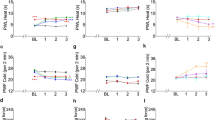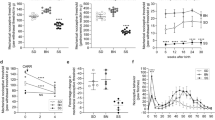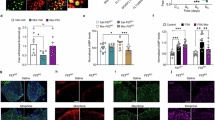Abstract
Opioids are a mainstay of pain management but can induce unwanted effects, including analgesic tolerance and paradoxical hyperalgesia, either of which leads to increased pain. Clinically, however, the relationship between these two phenomena remains elusive. By evaluating changes in mechanical nociceptive threshold in male rats, we found that in contrast to a purely analgesic control response to a single subcutaneous administration of fentanyl (25 μg/kg), in rats subjected to inflammatory pain 2 weeks previously (Day0), the same test dose (D13) induced a bi-phasic response: initial decreased analgesia (tolerance) followed by hyperalgesia lasting several hours. Both the tolerance and hyperalgesia were further enhanced in rats that had additionally received fentanyl on D0. The dose-response profiles (5 fg to 50 μg/kg) of pain- and opioid-experienced rats were very different from pain/drug-naive rats. At ultra-low fentanyl doses (<5 ng/kg and <500 ng/kg for naïve control and pain/drug-experienced rats, respectively), solely hyperalgesia was observed in all cases. At higher doses, which now produced analgesia alone in naive rats, reduced analgesia (tolerance) coupled with hyperalgesia occurred in pain/fentanyl-experienced rats, with both phases increasing with dose. Transcriptomic and pharmacological data revealed that an overactivation of the spinal N-methyl-D-aspartate receptor-inducible NO synthase cascade plays a critical role in both acute tolerance and hyperalgesia, and together with the finding that the magnitudes of analgesia and associated hyperalgesia are negatively correlated, is indicative of closely related phenomena. Finally, a polyamine deficient diet prevented inducible NO synthase transcript upregulation, restored fentanyl’s analgesic efficacy and suppressed the emergence of hyperalgesia.
Similar content being viewed by others
Log in or create a free account to read this content
Gain free access to this article, as well as selected content from this journal and more on nature.com
or
References
Dowell D, Haegerich TM, Chou R. CDC Guideline for Prescribing Opioids for Chronic Pain—United States, 2016. JAMA. 2016;315:1624–45.
Kalso E, Edwards JE, Moore RA, McQuay HJ. Opioids in chronic non-cancer pain: systematic review of efficacy and safety. Pain. 2004;112:372–80.
Relieving Pain in America. A Blueprint for Transforming Prevention, Care, Education, and Research. Institute of Medicine (US) Committee on Advancing Pain Research, Care, and Education. Washington (DC): National Academies Press (US) (2011).
Angst MS, Clark JD. Opioid-induced hyperalgesia: a qualitative review. Anesthesiology. 2006;104:570–87.
Célèrier E, Rivat C, Jun Y, Laulin JP, Larcher A, Reynier P, et al. Long-lasting hyperalgesia induced by fentanyl in rats: preventive effect of ketamine. Anesthesiology. 2000;92:465–72.
Laulin JP, Larcher A, Célèrier E, Le Moal M, Simonnet G. Long-lasting increased pain sensitivity in rat following exposure to heroin for the first time. Eur J Neurosci. 1998;10:782–85.
Mao J, Price DD, Mayer DJ. Thermal hyperalgesia in association with the development of morphine tolerance in rats: roles of excitatory amino acid receptors and protein kinase C. J Neurosci. 1994;14:2301–12.
Simonnet G, Rivat C. Opioid-induced hyperalgesia: abnormal or normal pain? NeuroReport. 2003;14:1–7.
Simonnet G, Laboureyras E. Hyperalgesia modulation and chronic pain after surgery. In: Postoperative Pain Science and Clinical Practice, IASP. Edited by Wilder-Smith O, Arendt-Nielsen L, Yarnitsky D, Vissers KCP Philadelphia: Wolters Kluwer; 2014. p 175–90.
Colvin LA, Bull F, Hales TG. Perioperative opioid analgesia — when is enough too much? A review of opioid-induced tolerance and hyperalgesia. Lancet. 2019;393:1558–68.
Rivat C, Ballantyne J. The dark side of opioids in pain management: basic science explains clinical observation. Pain Rep. 2016;1:1–9.
Guignard B, Bossard AE, Sessler DI, Lerault C, Alfonsi P, Fletcher D, et al. Acute opioid tolerance: intraoperative remifentanil increases postoperative pain and morphine requirement. Anesthesiology. 2000;93:409–17.
Lavand’homme P, Steyaert A. Opioid-free anesthesia opioid side effects: tolerance and hyperalgesia. Best Pract Res Clin Anesthesiol. 2017;31:487–98.
Weinbroum AA. Postoperative hyperalgesia — A clinically applicable narrative review. Pharm Res. 2017;120:188–205.
Célèrier E, Laulin J, Larcher A, Le Moal M, Simonnet G. Evidence for opiate-activated NMDA processes masking opiate analgesia in rats. Brain Res. 1999;847:18–25.
Célèrier E, Laulin JP, Corcuff JB, Le Moal M, Simonnet G. Progressive enhancement of delayed hyperalgesia induced by repeated heroin administration: a sensitization process. J Neurosci. 2001;21:4074–80.
Richebé P, Rivat C, Laulin JP, Maurette P, Simonnet G. Ketamine improves the management of exaggerated postoperative pain observed in perioperative fentanyl-treated rats. Anesthesiology. 2005;102:421–28.
Yu EHY, Tran DHD, Irwin MG. Remifentanil tolerance and hyperalgesia:short-term gain, long-term pain? Anaesthesia. 2016;71:1347–62.
Angst MS, Koppert W, Pahl I, Clark DJ, Schmelz M. Short-term infusion of the mu-opioid agonist remifentanil in humans causes hyperalgesia during withdrawal. Pain. 2003;106:49–57.
Compton P, Charuvastra VC, Ling W. Pain intolerance in opioid-maintained former opiate addicts: effect of long-acting maintenance agent. Drug Alcohol Depend. 2001;63:139–46.
Minville V, Fourcade O, Girolami JP, Tack I. Opioid-induced hyperalgesia in a mice model of orthopaedic pain: preventive effect of ketamine. Br J Anaesth. 2010;104:231–38.
Richebé P, Rivat C, Creton C, Laulin JP, Maurette P, Lemaire M, et al. Nitrous oxide revisited. Evidence for potent antihyperalgesic properties. Anesthesiology. 2005;103:845–54.
Rivat C, Laulin JP, Corcuff JB, Célèrier E, Pain L, Simonnet G. Fentanyl enhancement of carrageenan-induced long-lasting hyperalgesia in rats: prevention by the N-methyl-D-aspartate receptor antagonist ketamine. Anesthesiology. 2002;96:381–91.
Corder G, Donahue RR, Winter MK, Jutras BL, He Y, Hu X, et al. Constitutive μ-opioid receptor activity leads to long-term endogenous analgesia and dependence. Science. 2013;341:1394–99.
Kandasamy R, Price TJ. The pharmacology of nociceptor priming. Handb Exp Pharm. 2015;227:15–37.
Cabañero D, Campillo A, Célèrier E, Romero A, Puig MM. Pronociceptive effects of remifentanil in a mouse model of postsurgical pain: effect of a second surgery. Anesthesiology. 2009;111:1334–45.
Crofford LJ. Adverse effects of chronic opioid therapy for chronic musculoskeletal pain. Nat Rev Rheumatol. 2010;6:191–97.
Fletcher D, Martinez V. Opioid-induced hyperalgesia in patients after surgery: a systematic review and a meta-analysis. Br J Anaesth. 2014;112:991–1004.
Grace PM, Strand KA, Galer EL, Urban DJ, Wang X, Baratta MV, et al. Morphine paradoxically prolongs neuropathic pain in rats by amplifying spinal NLRP3 inflammasome activation. Proc Natl Acad Sci USA. 2016;113:3441–50.
Grace PM, Galer EL, Strand KE, Corrigan K, Berkelhammer D, Maier SF, et al. Repeated morphine prolongs postoperative pain in male rats. Anesth Analg. 2019;1:161–67.
Li W-W, Irvine K-A, Sahbaie P, Guo T-Z, Shi X-Y, Tawfik VL, et al. Morphine exacerbates postfracture nociceptive sensitization, functional impairment, and microglial activation in mice. Anesthesiology. 2019;130:292–308.
Martin LJ, Acland EL, Cho C, Gandhi W, Chen D, Corley E, et al. Male-specific conditioned pain hypersensitivity in mice and humans. Curr Biol. 2019;29:192–201.
Hirbec H, Teilhac J, Kamenka J, Privat A, Vignon J. Binding properties of [3H]gacyclidine (cis(pip/me)-1-[1-(2-thienyl)-2-methylcyclohexyl]piperidine) enantiomers in the rat central nervous system. Brain Res. 2000;859:177–92.
Hoizey G, Kaltenbach ML, Dukic S, Lamiable D, Millart H, D’Arbigny P. Pharmacokinetics of gacyclidine enantiomers in plasma and spinal cord after single enantiomer administration in rats. Int J Pharm. 2001;229:147–53.
Rivat C, Richebé P, Laboureyras E, Laulin JP, Havouis R, Noble F, et al. Polyamine deficient diet to relieve pain hypersensitivity. Pain. 2008;137:125–37.
Gaboriau F, Havouis R, Moulinoux JP, Delcros JG. Atmospheric pressure chemical ionization-mass spectrometry method to improve the determination of dansylated polyamines. Anal Biochem. 2003;318:212–20.
Rivat C, Laboureyras E, Laulin JP, Le Roy C, Richebé P, Simonnet G. Non-nociceptive environmental stress induces hyperalgesia, not analgesia, in pain and opioid-experienced rats. Neuropsychopharmacology. 2007;32:2217–28.
Kayser V, Basbaum AI, Guilbaud G. Deafferentation in the rat increases mechanical nociceptive threshold in the innerevated limbs. Brain Res. 1990;508:329–32.
Livak KJ, Schmittgen TD. Analysis of relative gene expression data using real-time quantitative PCR and the 2(-Delta Delta C(T)) Method. Methods. 2001;25:402–8.
Laulin JP, Maurette P, Corcuff JB, Rivat C, Chauvin M, Simonnet G. The role of ketamine in preventing fentanyl-induced hyperalgesia and subsequent acute morphine tolerance. Anesth Analg. 2002;94:1263–69.
Célèrier E, Gonzalez JR, Maldonado R, Cabanero D, Puig M. Opioid-induced hyperalgesia in a murine model of postoperative pain. Anesthesiology. 2006;104:546–55.
Laboureyras E, Chateauraynaud J, Richebe P, Simonnet G. Long-Term Pain Vulnerability After Surgery in Rats: Prevention by Nefopam, an Analgesic with Antihyperalgesic Properties. Anesth Analg. 2009;109:623–31.
Reichling DB, Levine JD. Critical role of nociceptor plasticity in chronic pain. Trends Neurosci. 2009;32:611–18.
Taylor BK, Corder G. Endogenous analgesia, dependence, and latent pain sensitization. Curr Top Behav Neurosci. 2014;20:283–325.
Vaccarino AL, Marek P, Kest B, Ben-Eliyahu S, Couret LC Jr., Kao B, et al. Morphine fails to produce tolerance when administered in the presence of formalin pain in rats. Brain Res. 1993;627:287–90.
Glare P, Aubrey KR, Myles PS. Transition from acute to chronic pain after surgery. Lancet. 2019;393:1537–46.
Sanna MD, Ghelardini C, Galeotti N. Regionally selective activation of ERK and JNK in morphine paradoxical hyperalgesia: a step toward improving opioid pain therapy. Neuropharmacology. 2014;86:67–77.
Gerhold KJ, Drdla-Scutting R, Honsek SD, Forsthuber L, Sandkühler J. Pronociceptive and antinociceptive effects of buprenorphine in the spinal cord dorsal horn cover a dose range of four orders of magnitude. J Neurosci. 2015;35:9580–94.
Wala EP, Holtman JR. Buprenorphine-induced hyperalgesia in the rat. Eur J Pharm. 2011;651:80–95.
Arout CA, Edens E, Petrakis IL, Sofuoglu M. Targeting Opioid-Induced Hyperalgesia in Clinical Treatment: Neurobiological Considerations. CNS Drugs. 2015;29:465–86.
Chu LF, Cun T, Ngai LK. Modulation of remifentanil-induced postinfusion hyperalgesia by the beta-blocker propranolol in humans. Pain. 2012;153:974–81.
Ferrini F, Trang T, Mattioli TA. Morphine hyperalgesia gated through microglia-mediated disruption of neuronal Cl(−) homeostasis. Nat Neurosci. 2013;16:183–92.
Larcher A, Laulin JP, Célèrier E, Le Moal M, Simonnet G. Acute tolerance associated with a single opiate administration: involvement of N-methyl-D-aspartate-dependent pain facilitatory systems. Neurosci. 1998;84:583–89.
Suzan E, Eisenberg E, Treister R, Haddad M, Pud D. A negative correlation between hyperalgesia and analgesia in patients with chronic radicular pain: is hydromorphne therapy a double-edged sword? Pain Phys. 2013;16:65–76.
Gühring H, Görig M, Ates M, Coste O, Zeilhofer HU, Pahl A, et al. Suppressed injury-induced rise in spinal prostaglandin E2 production and reduced thermal hyperalgesia in iNOS-deficient mice. J Neurosci. 2000;20:6714–20.
Tang Q, Svensson C, Fitzsimmons B, Webb M, Yaksh TL, Hua X-Y. Inhibition of spinal constitutive NOS-2 by 1400W attenuates tissue injury and inflammation-induced hyperalgesia and spinal p38 activation. Eur J Neurosci. 2007;25:2964–72.
Heinzen EL, Pollack GM. Pharmacodynamics of morphine-induced neuronal nitric oxide production and antinociceptive tolerance development. Brain Res. 2004;1023:175–84.
Wong CS, Hsu MM, Chou YY, Tao PL, Tung CS. Morphine tolerance increases [3H]MK-801 binding affinity and constitutive neuronal nitric oxide synthase expression in rat spinal cord. Br J Anaesth. 2000;85:587–91.
Zhou H-Y, Chen S-R, Chen H, Pan H-L. Opioid-induced long-term potentiation in the spinal cord is a presynaptic event. J Neurosci. 2010;30:4460–66.
Vardanyan A, Wang R, Vanderah TW, Ossipov MH, Lai J, Porreca F, et al. TRPV1 receptor in expression of opioid-induced hyperalgesia. J Pain. 2009;10:243–52.
Chen Y, Geis C, Sommer C. Activation of TRPV1 contributes to morphine tolerance: involvement of the mitogen-activated protein kinase signaling pathway. J Neurosci. 2008;28:5836–45.
Ossipov MH, Lai J, Vanderah TW, Porreca F. Induction of pain facilitation by sustained opioid exposure: relationship to opioid antinociceptive tolerance. Life Sci. 2003;73:783–800.
Chizh B, Headley PM, Tzschentke TM. NMDA receptor antagonists as analgesics: focus on the NR2B subtype. Trends Pharm Sci. 2001;22:636–42.
Kemp JA, McKernan RM. NMDA receptor pathways as drug targets. Nat Neurosci. 2002;5:1039–42.
Thompson TP, Whiter F, Gallop K, Veronese N, Solmi M., Newton P, et al. NMDA receptor antagonists and pain relief: A meta-analysis of experimental trials. Neurology. 2019;92:1652–62.
Mony L, Kew JN, Gunthorpe MJ, Paoletti P. Allosteric modulators of NR2B-containing NMDA receptors: molecular mechanisms and therapeutic potential. Br J Pharm. 2009;157:1301–17.
Seiler N. Pharmacological properties of the natural polyamines and their depletion by biosynthesis inhibitors as a therapeutic approach. Prog Drug Res. 1991;37:107–59.
Zhu S, Paoletti P. Allosteric modulators of NMDA: multiple sites and mechanisms. Curr Opin Pharmacol. 2015;20:14–23.
Bardocz S. The role of dietary polyamines. Eur J Clin Nutr. 1993;47:683–90.
Le Roy C, Laboureyras E, Laulin JP, Simonnet G. A polyamine-deficient diet opposes hyperalgesia, tolerance and the increased anxiety-like behavior associated with heroin withdrawal in rats. Pharm Biochem Behav. 2013;103:510–19.
Cipolla B, Guilli F, Moulinoux JP. Polyamine-reduced diet in metastatic hormone refractory prostate cancer (HRPC) patients. Biochem Soc Trans. 2003;31:384–87.
Cipolla BG, Havouis R, Moulinoux JP. Polyamine contents in current foods: basis for polyamine reduced diet and a study of its long-term observance and tolerance in prostate carcinoma patients. Amino Acids. 2007;33:203–12.
Neuman MD, Baterman BT, Wunsch HP. Inappropriate opioid prescription after surgery. Lancet. 2019;393:1547–57.
Strang J, Volkow ND, Degenhardt L, Hickman M, Johnson K, Koob GF, et al. Opioid use disorder/. Nat Rev Dis Prim. 2020;6:3.
Acknowledgements
We thank Jacques-Philippe Moulinoux, Ph.D., Professor (Faculté de Médecine and CHU de Rennes, Université de Rennes 1, 35043 Rennes, France) for gifting the Polyamine deficient rodent nutrient used in some experiments of this study. We are also grateful to Dr Romuald Nargeot for his invaluable assistance with our statistical analyses.
Funding
This work was supported by institutional and departmental resources from the Université de Bordeaux and Université de René Descartes Paris 5. We also received support from the ‘Conseil Régional d’Aquitaine Bordeaux’, the ‘Ministère de l’Enseignement Supérieur, de la Recherche et de l’Innovation’, and the ‘Centre Nationale de la Recherche Scientifique’. The Universities of Bordeaux and Rennes 1 have a patent (co-inventors J.P. Moulinoux and G. Simonnet) for a human form of polyamine deficient diet adapted from standard rodent nutrient ingredients.
Author information
Authors and Affiliations
Contributions
GS and EL designed experiments. EL conducted behavioral studies with the help of MBB. Tissue sample preparation, mRNA level determinations and data analyses were performed by AM and MP. GS, EL and JS interpreted the data and wrote the paper. All authors discussed the results and commented on the paper.
Corresponding author
Ethics declarations
Competing interests
The authors declare no competing interests.
Additional information
Publisher’s note Springer Nature remains neutral with regard to jurisdictional claims in published maps and institutional affiliations.
Supplementary information
Rights and permissions
About this article
Cite this article
Laboureyras, E., Boujema, M.B., Mauborgne, A. et al. Fentanyl-induced hyperalgesia and analgesic tolerance in male rats: common underlying mechanisms and prevention by a polyamine deficient diet. Neuropsychopharmacol. 47, 599–608 (2022). https://doi.org/10.1038/s41386-021-01200-5
Received:
Revised:
Accepted:
Published:
Issue date:
DOI: https://doi.org/10.1038/s41386-021-01200-5
This article is cited by
-
Interactions of pain and opioids on conditioned place preference in rodents
Psychopharmacology (2025)
-
Effect of different doses of esketamine compared with fentanyl combined with propofol on hypotension in patients undergoing painless abortion surgery: a prospective, randomized, double-blind controlled clinical trial
BMC Anesthesiology (2022)
-
Toward understanding the opioid paradox: cellular mechanisms of opioid-induced hyperalgesia
Neuropsychopharmacology (2022)



